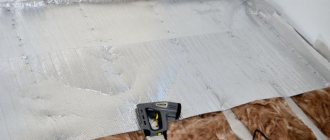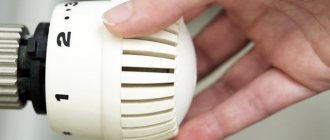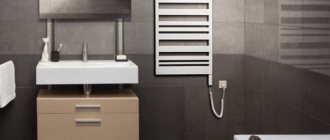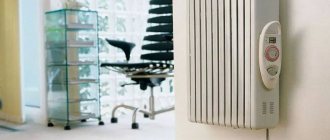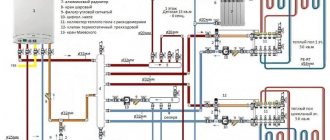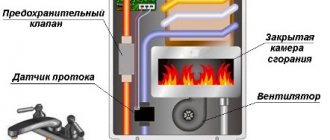Is it possible to have water floors in the bathroom?
Installing a water floor in a bathroom is a personal matter only in the case of a private home. According to the Housing Code, any independent change in the design of the heating system is illegal.
Complaints from neighbors about a decrease in heating intensity are grounds for initiating a lawsuit, which will result in an administrative penalty and an order to eliminate the changes within a short time.
Based on this, the legality of installing water-heated floors in an apartment building is questionable at best. The Housing Code allows you to change the design and layout of the heating system, but only after obtaining the necessary permits and coordination with the relevant authorities. In any case, registration should begin with a visit to the housing and communal services department.
Connecting a warm heated floor in a bathroom from a heated towel rail is one of the most commonly used solutions for heating a bathroom in a high-rise building. At the same time, it is extremely important to ensure that the heating temperature of your neighbors does not drop. A two-way valve can be used for this.
How to choose a coil?
Installing a heated towel rail with your own hands is a routine operation that even an inexperienced technician can handle. Before starting installation, it is important to correctly determine the appropriate device model. When choosing, you need to consider the following characteristics of the device:
- Connection points. There are heated towel rails with vertical, horizontal and universal connections. The choice of model depends on where the entry points into the heating system or connection to the riser are located.
- Form. Various models of coils can have one or several turns of pipe; devices in the form of a ladder are also very popular, with plenty of space for drying clothes.
“Ladder” shape - Distance between insertion points. This is a very important parameter, which is selected in accordance with the distance between the points of entry into the central heating system. If these two distances do not match, you have to use adapters, which reduce the reliability and tightness of the system.
- Material. When purchasing a device, you need to pay attention to the fact that it is made of corrosion-resistant material that is not afraid of constant contact with water. Stainless steel models are considered the best. The external coating can be chrome or paint depending on the style of the bathroom.
Copper coil
Please note that to successfully install a coil in a bathroom, you must accurately determine the appropriate model. Maximum attention should be paid to the diameter of the heated towel rail pipes and the distance between the connection points. If these parameters do not correspond to the connection location, you will have to use adapters for connection, which often cause leaks.
Warm water floor
The most economical, effective and safe option for creating autonomous heating is considered to be a heated water floor in a bathroom, which is a system placed in a screed and consisting of tubes (metal-plastic or plastic) through which the hot coolant moves.
Control over the temperature regime is carried out thanks to the presence of a device such as a thermostat. The coolant is circulated using special pumps included in the system.
There are two pipes in the manifold cabinet, one of which (supply) is filled with warm water supplied from the heating source to the heating system. The functional purpose of the other pipe (return) is to collect the cooling coolant and supply it back to the heating device.
Typically, consumers use a gas boiler for this purpose, in which the liquid becomes hot and is then transported again into the supply pipe. As already mentioned, the pressure in the system, and therefore the continuous movement of the coolant, is ensured by a special pump.
A heated water floor in a bathroom has a number of significant advantages when compared with an electric heating system:
- electricity is saved, the price of which tends to increase;
- there is no electromagnetic field and, accordingly, radiation.
The main disadvantages of a water floor are its complex installation and connection specifics. The fact is that in a private household or in an apartment where individual heating is installed, problems with connecting to a source of hot coolant should not arise.
But as for apartments with centralized hot water supply, in houses built a long time ago it is forbidden to connect a water floor to the heating structure. In addition, the bathrooms of such buildings do not provide heating. Connection is only permissible to a hot water pipe. But such actions are related to redevelopment, and for this you need to obtain permission from the relevant authorities. But, let’s face it, they still make underfloor heating from heating in the apartment, and many manage to do it quite well.
How to connect a heated floor?
Warm floors from hot water in an apartment are a heating system that uses the lowest water temperature. It consists of a network of pipes that run through the roof of the house, which will circulate hot water, thereby increasing the level of floor heating and warming the house.
Hot floor heating is one of the best heating methods on the market, but there are some considerations to take into account:
- Underfloor heating requires a medium to high initial investment compared to other heating systems (such as radiators), but the return on investment is short-term.
- Its height is 10-12 cm, so warm floors cannot be installed in some rooms. To do this, it is necessary to conduct a preliminary study on its adaptation, both for new construction and for reconstruction.
- Hot water underfloor heating is a fairly limited system in terms of the power it can offer.
How to adjust a heated floor
After installation of the flooring is completed, it is time to properly configure its parameters. What should I pay attention to when adjusting the temperature of underfloor heating?
The adjustment of the heated floor is taken into account during its installation. The installation must be adjusted in such a way that each heating circuit receives a flow of water at a certain flow rate, determined by the required heating output. This is achieved by equalizing the hydraulic resistance in individual water circuits using valves. Accuracy and ease of adjustment are ensured using flow meters (rotameters). With underfloor heating, both the floor temperature (so that it does not exceed the permissible value) and the air temperature (to ensure comfort for people in the rooms) must be regulated.
Limiting the temperature of the heated floor is achieved by maintaining the interval between the pipes and the water supply to the system no higher than 55°C. This is achieved by appropriately setting the heat source regulator - then the entire heating system is supplied with water with such heating. This is a good solution if you have underfloor heating throughout the house.
How to turn off the hot floor? The floor is easy to turn off using the thermostat. If the floor does not turn off, then there is a breakdown somewhere. When using hydronic heating in only one or two small rooms, such as bathrooms, it is not recommended to use a complex system to reduce the temperature of the water flowing through them. Some installers connect them in series with the radiator - the water that has already cooled in the floor gets under it. Such a simple solution does not allow independent control of the temperature of the radiator and the floor.
Therefore, it is better to connect radiators and underfloor heating in parallel and use a valve that limits the temperature of the water returned from the system. It closes the flow when its temperature exceeds the set value. Then the water cools and the valve opens. So, despite the supply of hot water, the floor temperature can be maintained at an acceptable level.
In the case of underfloor heating, it is more important to have a slightly more advanced control system than a simple thermostat, since with the help of a suitable controller it will be possible to set it in such a way as to anticipate cold conditions and provide the necessary comfort at any time of the day. It is recommended that connections be made by an electrician or installer. The thermostat is installed in each room at a minimum height of 160 cm and the ambient temperature is marked not higher than 26 or 28 ºC.
Operating principle of heated floors
In order to have an idea of how a warm water floor in a bathroom works, let’s look at a simple everyday situation. After laying the pipeline, the contour is filled with a new concrete screed or a stacked deck or wooden structure is installed. Two pipes, supply and discharge (return) are connected directly to the collector. The heating temperature is controlled using a thermostat.
Boiler water heated to a temperature of 35-450 or water from a centralized hot water supply system, only at a much higher temperature, enters the supply pipe. Through the return pipe, the cooled coolant flows back into the boiler or returns to the domestic hot water system.
Note: if you have a large bathroom, connecting a heated floor to a centralized hot water system can negatively affect the quality of water heating. Not only the residents of your apartment will suffer from this, but also your housemates. It is officially prohibited to connect the water circuit of a heated floor to a centralized heating system. To connect to the hot water system, you will need to obtain permission from regulatory authorities.
Such difficulties often become an obstacle to installing a water-heated floor in a bathroom in a city apartment. The way out of this situation is to install an electric heating element, the installation of which will take less time and will have virtually no effect on the functionality of the main house systems and communications. Usually in private houses the bathroom is located near the boiler equipment, so there is no need to spend money on laying additional pipes. The entire home heating system can be designed taking into account the subsequent connection of an additional heating circuit, both in terms of hydraulic load and in terms of the operation of the heating device.
When it comes to connecting a heated floor to an autonomous heating device, the heating circuit is equipped with a circulation pump. If installation is carried out to a central hot water supply, a pump is not required. The diagram shows the connection of a heated floor to a heated towel rail.
Popular types of heating devices
The modern market of heating devices offers a fairly wide selection of devices designed for heating bathrooms. These include:
- metal water heating radiators;
- infrared heaters;
- convective-infrared heaters;
- oil instruments;
- electric convectors;
- fan heaters;
- cast iron radiators.
To have an idea of the different types, you can consider the characteristics of the most popular models.
Water heating radiators
Popular with users. Such devices have replaced old, cast-iron radiators. Connecting a heated towel rail to a hot water riser is easy.
The advantages of such devices include:
- long service life;
- low price;
- a light weight;
- simplified installation process.
The connection diagram of the device is quite simple; any master can handle connecting the heater. In addition, this device does not consume electricity, unlike other heaters.
Important!
Connecting a heated towel rail to a boiler is also possible; this is especially true for residents of houses with no hot water supply system.
Panel heaters
It is not the air in the room that warms, but the walls and floor. The installation location of the device is the ceiling.
Such heaters do not take up room space; they are advisable to use in rooms with a lack of free space. In addition, such a heater meets the most stringent safety requirements.
The design of such a device is complex; it can function fully in rooms even with extreme humidity levels.
Also interesting: Decorating a bathroom with wood – natural elegance
The advantage is energy savings - the beams of the device, depending on the need, can be directed in any direction.
The disadvantage is the high price. Bathroom heating mats work on this principle.
Infrared models
The heating element in convective-infrared modular heaters is an element made from a special threshold with a nichrome thread inside.
This device can be hung on the wall; by the way, it does not spoil the appearance of the room at all. The power of the device is adjusted using a thermostat.
You can place the heater not only on the wall, but also on the ceiling, and the device will warm the room equally well.
The heating element is a ceramic panel, which is a radiator.
Once heated, it emits infrared waves. They do not come into contact with air, but affect surrounding objects. Such devices can be used in conditions of high humidity.
The undoubted advantage is that they do not produce unpleasant noise, unlike fan heaters, and act as a source of lighting at night.
When choosing a heating device, you need to start not only from taste preferences. It is important to compare the power of the device with the dimensions of the heated room. A summary table will help you understand these parameters:
| Area (sq.m) | Required power of the device to ensure optimal heating (W); |
| 5-6 | 500 |
| 7-9 | 750 |
| 10-12 | 1000 |
| 12-14 | 1250 |
| 15-17 | 1500 |
| 18-19 | 1750 |
| 20-23 | 2000 |
The use of insufficiently powerful appliances in large bathrooms is unjustified; this will lead to energy costs, but the heat generated will not be enough to fully warm up the room.
Fact!
The internal part of the heater warms up to 150°C, but the body temperature does not exceed 60°C.
Oil appliances
They are one of the most popular devices. An electric spiral, which is placed inside the device, heats up the oil, due to the boiling of which the body is heated, and after which the air in the room warms up.
Presented in a metal case with a ribbed structure. They are installed using special anchors that come with the device.
Advice!
Such fittings may not be of very high quality, so it is better to purchase a set of anchors separately. The heating element of such a device is a heating element, and the coolant is oil.
The design is resistant to corrosion, as the surface is covered with enamel. The thermostat protects the device from overheating, which also affects energy consumption.
The device turns off automatically after the air in the room warms up to the required temperature. An oil radiator can be used to dry clothes.
The advantages also include:
- high maximum temperature;
- operational safety;
- no noise;
- automatic shutdown when overheating;
- wheels for ease of movement.
Also interesting: Which boiler connection diagram to choose?
Preference should be given to devices with a built-in air ionizer, because oil heaters dry out the air in the room.
You should not purchase cheap models, because during operation they can emit an unpleasant odor.
Electric convectors
Used for space heating. The device consists of a metal body and an internal heating coil. The air passes through the heating part and warms up.
It is worth noting that the efficiency of such heaters improves if such devices are located below.
When choosing heaters of this type, you should pay attention to:
- devices with a ceramic heating element do not burn air;
- for use in the bathroom, preference should be given to devices with high protection against moisture;
- the advantage will be the presence of wheels for free movement of the device;
- room heating speed.
The disadvantage of devices made according to this scheme is that they have a built-in fan, which often acts as a source of excess noise.
Fan heaters
They are the simplest heating devices, and many users choose them for heating bathrooms. The power of such devices is quite high.
They are quite compact, so they can be installed on the floor or other flat surface.
A fan heater is a simple device consisting of a plastic housing, a fan and a heating coil.
Among the advantages are:
- low cost;
- ease of use;
- device mobility;
- ability to quickly warm up the room;
- ease of operation;
- small sizes;
- modern appearance.
The device has certain disadvantages, for example, it makes annoying noise and emits an unpleasant odor.
How to install heated floors in the bathroom?
If you want to install the system yourself, then first you can familiarize yourself with the installation technology and start working on your own.
Essentially, an electric floor heating system is a separate element from the main floor that is installed before or during the flooring.
This system consists of heating cables or mats that are installed on a concrete pad and then firmly attached to the old base.
The mats are made of fabric with heating parts woven into it, firmly protected and insulated from moisture. To connect to the power grid, free communications 4 meters long are connected to each mat from the beginning and end.
The system is powered from a network with a voltage of 220V. Using a built-in sensor, the temperature of the heated floor in the bathroom is measured, and the required heating is installed using an electronic thermostat.
Types of heated towel rails
A heated towel rail is a bathroom heating unit used for drying small items. It usually comes in the form of a curved pipe through which coolant circulates.
The model with a water circuit works complete with fittings that are connected to the hot water supply system, and the electric version operates using a built-in heating element.
Both types of devices function the same way: the coolant heats a pipe fixed to the wall, moisture from hanging towels or linen evaporates quickly, and they dry.
Heating a bathroom floor using electricity is absolutely safe, since all components are insulated under the floor covering during the process. An electric floor is easy to use, since there is no coolant, which means that incidents with flooding are eliminated and a powerful screed under the covering is not required.
Warm floors from a heated towel rail can be installed electrically using heating cables with a single or double wire.
When choosing electric heating in the bathroom, you need to focus on the free space without a washing machine, shower stall, or plumbing furniture and purchase a cable taking into account only this space.
In addition to cables, you can lay a heating mat, which comes in the form of a regular thermal cable fixed to a reinforcing fiberglass mesh.
Instead of cables and mats, you can use a more modernized option - installing infrared carbon films that emit and accumulate heat: with this method, a cement screed is not required, the film system is installed directly under the floor covering
We recommend: What is National Comfort underfloor heating?
How to install an electric floor:
- the subfloor for installing electric floor heating must be perfectly flat without cracks or chips. Insulation is placed on it for thermal insulation so as not to lose heat during operation. Expanded polystyrene boards trimmed with foil can be used as insulation;
- Next, a waterproofing layer is required; for this, install a roll of membranes, pressing it to the base;
- a damper tape with a width of 20 cm is glued around the perimeter of the bathroom to create a buffer;
- fix the heating cable or mats to the base on the adhesive mounting tape manually, placing them on a substrate, for example, on a metal mesh;
- the end of the cable is connected to the coupling, drowning it after filling the screed;
- install a thermostat mounted into the wall a meter above the floor;
- to connect wires to the sensor, drill a hole to the floor, place the sensor in a special corrugated pipe, then connect the wires to the thermostat;
- after checking all the elements for defects, pour a cement-sand screed on top of the heating cable in an even layer with a thickness of 30-40 mm;
- After the layer of composition has dried, the tiles are laid, observing the correct installation technology.
If it is impossible to raise the floors to the required level, you can lay the cables in grooves (grooves) on the surface of the concrete base. This technology cannot be made on a foam concrete base; the material has low thermal conductivity.
According to the installation technology of any type of arrangement, an unreasonable increase in the thickness of the concrete screed is not recommended. The floors will take a long time to heat up. The sensor will not be able to respond quickly to temperature changes.
Preparing for installation of heated floors
First of all, you need to decide how to insulate the floors in the bathroom. Depending on the choice of heating system, a plan and project are drawn up. The diagram shows the place where the sensor and thermostat will be mounted and the heating element connected.
In this case, one should take into account the inadvisability of heating the floor under the bathtub and in the washbasin area. Thanks to the diagram, you can easily calculate the amount of materials.
Step 1. Installing the thermostat
It is advisable to start installing a heated floor in the bathroom by installing a thermostat (thermostat). This is the most important part of the system, which serves to automatically control the degree of heating of the heated floor.
The bathroom thermostat kit includes a floor temperature sensor. This device transmits temperature data to the thermostat, which in turn controls that the heated floor in the bathroom is heated only to a certain temperature. Once this happens, the thermostat turns off the system and turns it back on only when the floor has cooled down.
The thermostat is usually installed in the same room where the heated floor is installed. However, it is not recommended to do this in wet rooms (including bathrooms) due to possible automation failure. Therefore, the best option is to install a floor temperature sensor in the bathroom, and a thermostat in the adjacent room.
First, you need to knock out a small recess in the wall for mounting the thermostat installation box. This is done at a height of 50-100 cm from the floor surface. After this, two vertical grooves are cut from the resulting recess to the floor using a grinder or a chisel with a hammer. After laying the cable and installing the sensor, two tubes are placed in the resulting grooves, one of which is fed with power wires, and the other with sensor wires.
The thermostat is mounted in a recess knocked out in the wall in the same way as a regular switch
Step 2. Preparing the subfloor
Since no “dirty” work is expected after knocking out the grooves, the time has come to clean the base of the floor from debris and construction dust. The floor must be level, without visible differences in height. If necessary, the floor is leveled with cement screed or self-leveling mixture.
After the floor is leveled, its surface is primed and the primer is allowed to dry.
Step 3. Laying thermal insulation
A mandatory step in installing heated floors is thermal insulation. It is necessary if you do not want to waste the energy of the heated floor on heating the underlying premises: a neighbor’s apartment or basement. In this case, your system will wear out, and the lion's share of energy will go down the drain, taking away significant amounts from your budget.
Therefore, any heat-insulating material with a thickness of at least 20 mm is laid on the subfloor. This can be expanded polystyrene, penofol, penoplex, polystyrene foam, foil polyethylene foam, cork, etc.
Step 4. Laying the heating cable
Cable laying begins from the place where the power wires are connected to the thermostat. Steel mounting tape is attached to the thermal insulation in 0.5 m increments. The heating cable is laid on top, usually in a zigzag pattern, and secured to the floor with mounting tape tabs.
Installation of a water heated floor
Installation work is carried out in stages:
- First of all, before making a warm water floor in the bathroom, you need to dismantle the old covering and remove the screed to the base. Since you will be working in a dusty environment, you should take care of respiratory protection.
- Then the rough base must be leveled as much as possible using self-leveling mixtures or cement screed if the height of cracks and other defects exceeds 10 millimeters.
- Then the location of the collector and other system control elements is determined. They must be freely accessible. Usually the cabinet is placed at a low height from the floor. Pipes coming from the heating boiler are inserted into it and shut-off valves are installed. A collector in the form of a tube and the branches from it are connected to these elements, and then a pipeline for hot coolant is connected to them.
- Rolled waterproofing material is laid on the surface of the base. Its sheets are laid out overlapping, paying special attention to the tightness of the joints. A special tape is used for this. We should not forget about the need to make a 10-centimeter overlap on the surface of the walls.
- A thermal insulation layer is installed from technical cork, mineral wool, special mats, or expanded clay is poured. If the room is located on the ground floor, the thickness of the thermal insulation should be at least 10 centimeters. When the bathroom is located above a heated living space, a 5-centimeter layer will be sufficient.
- A reinforcement mesh or a special frame is mounted on top of the insulation. Pipes with water are placed on them. Experts recommend starting from the far corner. In most cases, a 25-50 cm distance between pipes is maintained. They are laid in a spiral or snake. You need to know that when installing heated floors in a bathroom with your own hands, the gap between the wall and the outer pipes should not exceed 8 centimeters.
- The supply and return pipes are connected to certain manifold valves. Start checking the system for functionality. For this purpose, supply heated water and look for leaks. The coolant supply is turned off.
- Before proceeding to the final stage, it is necessary for the floor to cool completely. Then another layer of screed is poured, not forgetting to control the horizontalness of the coating. The height should be 3-7 centimeters. After the base has dried, the heated floor in the bathroom under tiles or other covering is ready. It is allowed to operate the heating system no earlier than after a month - otherwise voids will appear in the screed or it will crack.
Materials and equipment
So, you already have a working boiler with a circulation pump, to which you can connect a heated floor. To install heating in the bathroom, you will need:
- Pipes. Special, for water heated floors (not “ordinary” ones, which are used for the installation of sewerage and water supply systems). For self-installation, it is more convenient to use more affordable metal-plastic than expensive cross-linked polyethylene. Such a pipe is easier to bend and hold in a bent form, but in the bathroom you will have to make a lot of sharp bends. The amount of pipe is approximately 5–7 m per square meter of room. Don’t forget that you don’t need to install heated floors under the bathtub and/or shower stall, so their area can be immediately subtracted.
- Collector (comb) for heated floors. It can be purchased assembled or assembled from individual components. With a bathroom area of up to 5 sq. Many home craftsmen manage to do without a collector. In this case, conventional shut-off valves with a thermostat are used instead. But this solution should only be considered if you have a good boiler with a powerful pump. A “weak” heating system will not be able to provide sufficiently intense circulation in the pipes in the floor.
- Shield (cabinet) for the collector. It must be installed in the bathroom, in a place convenient for access. Therefore, immediately pay attention to the size, general appearance and quality of the cabinet finish. You won't be able to hide it later. A more elegant option is to install the collector in a niche in the wall and close it with a door. But this is much more difficult to implement.
- Reinforcing mesh and fasteners for securing pipes (plastic clamps).
- Materials for pouring screed. Choose a mixture that is designed for use with heated floors. An ordinary screed without a plasticizer will not withstand constant heating and will soon simply crumble.
- The backing is foil polystyrene, polyethylene or polypropylene. There are many similar materials that differ markedly in price and properties, so their choice is a completely separate topic. Let's just say that you can take a substrate with protrusions (“bobs”), between which pipes can be easily secured. It costs much more than “flat” materials, but it is easier to work with. You cannot save too much on the substrate - it must be quite dense (at least 35 kg/m3) and thick (from 30 mm). Soft foam plastic will not provide the necessary strength, and too thin insulation will transmit some of the heat to the lower floor.
- Waterproofing materials (roll or coating). Despite the fact that any substrate is equipped with a waterproof layer, general waterproofing of the bathroom cannot be abandoned. And although waterproofing work is not formally included in the concept of installing heated floors, they will have to be performed at the surface preparation stage. When removing the old screed, the existing waterproofing will most likely be damaged.
- Damper tape.
- Aluminum tape for gluing seams between individual backing plates.
Electric or water
Electrical kits are thermal cables or mats that, during operation, warm the floor and room to a predetermined temperature. This type of system is in demand in almost all regions of our country due to its impressive range of various advantages.
Table 1 . Electric TP for the bathroom: pros and cons
| № | Pros of ETP | Disadvantages of ETP |
| 1) | Compatible with all types of bases (concrete screed, prefabricated wood flooring, chipboard, OSB). | When developing a plan, special attention is paid to stationary objects under which overheating zones may form. |
| 2) | Autonomy from centralized heating systems. The result is uninterrupted operation. | High level of electricity consumption. |
| 3) | Possibility of choosing the type of electric heating depending on the facing material in the bathroom. For porcelain tiles - cable TP, for laminate, plank flooring and vinyl tiles - infrared mat or low-temperature "soft heat" cable. | Difficulties in working with frequent interruptions in electricity supplies and the need to purchase uninterruptible power supplies (generators, batteries). |
| 4) | There is no need to purchase or install heat generators (boiler equipment, heat pumps, etc.). | Repairing the cable most often requires complete dismantling of the floor covering. |
| 5) | Variable power - selected based on the characteristics of the room, taking into account the table of correction factors provided by heating circuit manufacturers. | Electromagnetic radiation generated during the operation of the system can negatively affect the health of older people. |
| 6) | The thickness of the floor cake is from 1 cm (depending on the type of ETP used). | |
| 7) | Can be used as a main or additional heating system. | |
 | Efficient heating even with 55% floor coverage | |
| 9) | Availability of automatic control and security system (overheat protection, RCD, etc.). | |
| 10) | Low noise level. Cable TP is characterized by a barely audible hum. | |
| 11) | Some types are characterized by simple installation with a minimum of time and financial costs. | |
| 12) | Local repairs of individual sections or segments of the floor are allowed. | |
| 13) | Service life – from 10 years or more. |
The costs of purchasing and installing electric heating for sanitary facilities are relatively low. For example, for a bathroom with an area of 8 m², the cost of a turnkey cable floor is about 20-35 thousand rubles (at 2021 prices for Moscow and Moscow Region). It can be installed in apartments, private houses (including wooden ones), hotels, boarding houses and other commercial organizations.
Note that an electric heated floor in a bathroom may not be too expensive if it is used not constantly, but periodically, for several hours a day. Operating costs can also be reduced by:
- using a two- or three-tariff grid;
- reducing the heating temperature by 1-2 °C;
- installation of programmable thermostats, various automatic control controllers.
- automatic shutdown at night and when no one is home.
Manufacturers offer three basic types of ETP: cable, rod and film. They differ not only in characteristics, but also in installation technology.
Water heated floors are the most popular type in the private sector. Since the system is quite cumbersome and multi-component, it is rarely installed exclusively for the bathroom, but rather in conjunction with other rooms.
Water heated floor (WHF) includes the following components:
- Pipelines and components for them.
- Main mixing unit.
- Thermal energy generator.
Pipes are used to form contours along which the coolant (water, antifreeze, etc.) subsequently circulates. In this case, the channels can be:
- metal, that is, made of copper, stainless steel (corrugated pipe);
- plastic, for the production of which polymer masses are used - polypropylene, cross-linked polyethylene, metal-plastic.
The choice of pipelines is most often influenced not only by price indicators, but also by personal preferences. Any of the above materials is perfect for installing water heated floors. Especially considering the fact that the recommended coolant temperature is from +40 to +60 °C.
For the control and normal functioning of the system, a collector and mixing complex will be required, including:
- metal or thermoplastic manifold;
- circulation pump;
- a variety of fittings, valves, sensors and much more.
Of course, dealers have both completely ready-made kits and components for individual configuration on sale.
Boiler equipment is used as a heat source in the HTP: gas, solid or liquid fuel, electric, combined. The type of boiler is determined based on the main parameter – fuel availability. For example, for apartments, owners try to choose between gas and electric installations. Let us remind you that it is not recommended to connect water underfloor heating to a centralized heating system or hot water supply for apartments located above the second floor. In any case, careful calculation and approval by the governing bodies is necessary.
For private homes, in addition to classic solutions, there are alternative ones from Aeg, Vaillant and other major manufacturers. These are heat pumps, solar collectors, etc. The source of heat for them is the bowels of the earth, air, etc.
Despite the assurances of well-known component manufacturers, water heating is not full of advantages. It also has disadvantages. Here is a comparison table.
Table 2 . Water TP for the bathroom: advantages and disadvantages
| № | Pros of ETP | Disadvantages of ETP |
| 1) | When installed correctly, the ETP is compatible with any type of rigid base (mineral, organic, composite). | Expensive equipment, labor-intensive installation. |
| 2) | It is allowed to lay any types of decorative finishing coatings over the HTP: parquet, laminate, linoleum, tiles, carpet, etc. | Local repairs are impossible without partial dismantling of the floor “pie” |
| 3) | A wide selection of all kinds of heat generators, as well as security systems. | Due to the need to install insulation and screeds, the total thickness of the floor starts from 3.5 cm. |
| 4) | High energy efficiency in the presence of automation systems, a decrease in coolant temperature by 2-5 degrees and the use of economical boiler equipment (energy saving classes according to ELD 2010/30/EU A+++, A+, A, B+). | Periodically, servicing of some elements of the HTP (boilers, pumps, etc.) is required. |
| 5) | Use as a main or additional heating complex. | |
| 6) | If you have a heat generator, you will be independent from central heating systems. | |
| 7) | There are two main methods of installing the system: wet and dry (using mounting sheets made of polystyrene foam, metal, chipboard sheets, etc.). | |
 | Operational safety. | |
| 9) | Low noise level during operation. | |
| 10) | Low cost during operation, especially when using cheap thermal energy (from hot water supply systems, centralized heating or natural gas). | |
| 11) | There are no areas of probable overheating under stationary objects, which is especially important when installing heated floors in the bathroom. | |
| 12) | Service life - more than 20 years. |
Thus, the system has many more advantages than disadvantages. And here both the quality of components and compliance with the rules during the installation process play an important role. The ETP is installed for more than one year, so it is not worth saving on components or specialists.
If underfloor heating is done only in the bathroom, then there is only one choice - electric models. Water heated floors are usually made for the entire house (floor) or apartment; it is much more economical, but not all apartments can install it.
Installation of film UV floor
If you have doubts whether you need a heated floor in a water or electric bathroom, you can consider an innovative option for heating the floor surface - film.
The work associated with the installation of infrared heated floors is similar to that performed when laying cables. The difference lies in the spreading of the film sheets parallel to each other. There is one important advantage of a UV floor - it can be used without pouring a screed directly under the floor covering, which could be, for example, ceramic tiles. The film is embedded in the tile adhesive solution.
There is another way to install a UV floor - dry using a special protective film material. Only then the finishing coating is laid.
Simple installation and simple operation make electric heating for the bathroom floor the best solution.
- Parquet
- Laminate
- Linoleum
- Skirting boards and thresholds
- Installation and repair
- Wooden
- Other materials
- Warm floor
- Leveling and screed
- Tile
- Finishing and decor
Pros of heated floors in the bathroom
Walking barefoot after a shower on the cold surface of the tiles in the bathroom is unpleasant, especially in the cold season. For this reason, installing an underfloor heating system is a good solution for every property owner.
Installing heated floors in the bathroom can be called a modern solution.
A heated floor surface allows for uniform movement of warm air masses throughout the room, and in addition, the coating will always be dry. Drops of water that fall on the floor will dry almost instantly. Indoors, even in the most humid areas, there will be no conditions for the growth of mold and mildew.
Installing heated floors in the bathroom will allow:
- maintain a comfortable microclimate in it;
- remove excess moisture that appears after family members take the procedures;
- dry the moist air from wet things on the heated towel rail.
In residential buildings, two types of floor heating systems can be installed for rooms where there is high air humidity - water and electric.
What is a heated towel rail?
A heated towel rail is an additional heating device for the bathroom, which heats the room to an acceptable temperature. Its design is quite simple; it consists of a curved pipe, fixed with the help of special brackets on the wall of the bathroom. It performs the following functions:
- Heating the room. And the bathroom does not provide for the installation of wall-mounted heating devices, so the inside of this room is always a little cooler than in the rest of the apartment. This is especially felt after taking a bath, because if a body heated by hot water is suddenly cooled down, you can get sick. The heated towel rail in the bathroom raises the temperature to comfortable levels.
Heated towel rail - Reducing humidity in the bathroom. Due to constant contact with water, there is always high humidity in the bathroom; because of this, the finishing of the walls, ceiling or floor, and furniture often suffers. Due to its temperature, the heated towel rail dries the room, making the microclimate of the bathroom more acceptable and comfortable.
- Drying clothes. A heated towel rail in the bathroom is most often used for drying linens and other bath accessories. This is a very useful function of this indispensable device, especially if it is connected to a hot water supply system and not to heating, then it will help dry clothes even in summer.
Note! A heated towel rail is a curved metal pipe that is attached to the wall in the bathroom. Metal is a good conductor, so it perfectly transfers heat to the surrounding space. Thanks to this, the inside of the bathroom becomes warmer and more comfortable.
Flaws
Like any installed system in the house, it has its drawbacks:
- The cost of the system for the buyer will not be a small amount. But it will be justified after the first uses, because you simply won’t want to leave a comfortably furnished bathtub.
- Not all floor coverings that you would like to use in your bathroom can be used as flooring. The most practical would be ceramic tiles and self-leveling flooring. It is rational to install a wooden floor only if there is good ventilation in the bathroom, otherwise such flooring will soon have to be replaced.
- Electric floor heating requires electricity. Therefore, before installing any type of heated floor, you need to calculate all the pros and cons and choose which one is better, otherwise the floor simply will not be useful, because it will be very expensive to use.
This is what a heated floor looks like in cross section
Installation of heated floors, electric or water, which is better, has to be chosen only by the owner of the house or apartment. The cost of any system will not be cheap, but it will require significantly less costs when installing the floor yourself. If the electric one can be turned on even in the summer, then water floor heating will only work with the start of the individual heating system. The system sensor shows the temperature no higher than 40 degrees, but the heating can be changed using a thermostat.
Heated towel rail connection types
A heated towel rail is a device designed to heat the bathroom, although it is sometimes installed in the kitchen. Its main task is to dry wet towels, clothes, etc., as well as the room itself, which allows you to maintain the optimal temperature.
Heated towel rails are available in electric or water type. To power heated floors, water batteries are used, which are divided according to the method of connecting the coil:
- from central heating;
- from hot water supply.
If the heated towel rail is connected to central heating, then when the heating season begins, the coil is filled with hot water, and from there it flows into the heated floor pipes, thereby warming the surface.
For your information! Since the device operates from the central heating of the apartment, at the end of the heating season the floor stops heating. Its operation resumes when the heating is turned on.
Warm floors in the bathroom will function more efficiently when the coil is connected to the hot water supply. The floor will be heated almost constantly, except for periods when the hot water is turned off, or when you yourself close its supply to the pipeline.
Adviсe
If you are installing a heated floor with your own hands, then you will need advice on choosing individual elements of the system
If you are installing a heated floor with your own hands, then you will need tips on choosing individual elements of the system:
- All water floor heating designs differ in power. It, in turn, depends on the diameter of the selected pipes and installation features. The calculation of the required power of a water floor is made taking into account the size of the bathroom, its location in the house, as well as taking into account the type of future floor covering. To perform the correct calculation, it is better to contact specialists.
- When choosing a collector, circulation pump or heating boiler, it is worth remembering that they may also differ in their technical characteristics. For example, there are collectors with or without functions that allow you to regulate coolant circulation. Usually the first collector option is more expensive. If you are not going to regulate the degree of floor heating, then you should not overpay and you can buy a cheaper unit without this function.
Video on how to make heated floors in the bathroom with your own hands:

